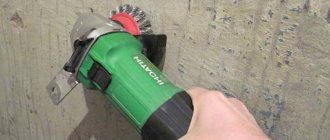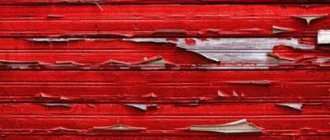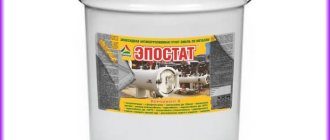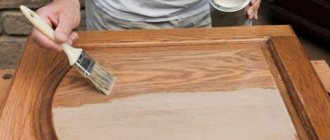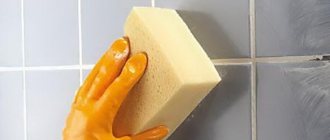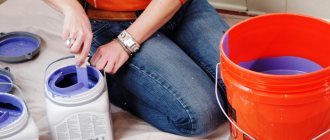Before applying new paint to a product, it is necessary to remove the previous layer, otherwise adhesion will be poor and it will not be possible to create a high-quality coating. But when working with metal and other surfaces, the grinding process is quite complicated and during work a lot of dirt is formed, which takes a lot of time to remove. Manufacturers have solved this issue by creating various removers that have a chemical composition and make it possible to reduce this process in terms of effort and time. Existing paint removers will be discussed in more detail below.
Do I need to remove old paint?
If during renovation a wall with old paint is covered with plasterboard, then there is no need to waste time dealing with the residue.
But if the plans include treating this particular surface, then the previous coating will have to be removed. Otherwise, the tile will not stick (and even if it does, it will fall off very quickly), and the wallpaper will come off as soon as the glue dries. It is generally impossible to predict how the new paint will behave on the old one.
Did you know? The word "repair" comes from France. It was originally used in the army to mean “to change an old horse to a young one.”
- what kind of paint is on the wall now, how many layers;
- what type of surface we are dealing with;
- what tools are available;
- event budget.
Most often, it is the first point that causes difficulties. The paint can be acrylic, water-based or oil-based. Even if an experienced craftsman can determine the type of paint by eye, it is not possible to guess the layers. Therefore, it is recommended to select a small area of the wall for experiments, so that you can determine the most effective cleaning method in practice.
The type of surface is usually easy to distinguish even for a novice craftsman: wood, metal or concrete. The most difficult combination to remove is oil paint and concrete.
Let's take a closer look at the instrument.
Find out how to build a cellar with ventilation, a sheepfold, a chicken coop with ventilation, a veranda, a gazebo, a barbecue, a fence with your own hands.
Useful tips
The process of cleaning metal is very complex and time-consuming. However, if you take into account the following tips, you can make the procedure easier and more effective:
- Typically, paint removers are quite effective, however. If you first wash the surface thoroughly with warm water and soap, this will allow the remover to penetrate deeper into the paint layer and enhance its effect.
- Often the composition used evaporates too quickly. In order to prevent this, wax or paraffin is added to the composition. However, some cleaning products do not contain such ingredients. In this case, the situation can be corrected using plastic film. After applying the remover, it is enough to cover the metal with a layer of polyethylene so that evaporation slows down to an acceptable degree.
Processing old car body paint Source gidpokraske.ru
Chemical methods
Methods for removing old coating using chemical reagents can be called the least labor-intensive. You just need to carefully distribute the product on the surface, let it act on the paint for the recommended time, and then remove the softened coating.
No. 9. Ready-made paint remover
The time interval is always indicated on the packaging, as well as recommendations for use, which we advise you to strictly adhere to.
All chemical compounds have pungent, unpleasant odors and are very aggressive. Be sure to work with gloves and a respirator, and while the solution is working, it is better to leave the apartment altogether, opening the windows for ventilation; Also, after completing the work, you cannot simply take and pour the remaining solution into the sewer. Chemicals are very caustic and must be disposed of properly. This is also mentioned on the packaging or in the instructions; The cost of such products can also be intimidating, but believe me, after you try to remove paint with a spatula, an ax or a grinder and none of the above gives the desired result, you will not want to save
Often, one liter of solution is enough to remove paint from the walls of a standard-sized bathroom and toilet; Please also note that some compounds may be intended for use only on horizontal surfaces.
Depending on the component of the base, ready-made compositions are:
- Acidic - based on hydrochloric or phosphoric acid;
- Alkaline - based on salts of various origins;
- Organic - which does not contain any salts or acids.
For removing old paint from stone surfaces, acid-free compounds are considered the most suitable.
According to the release form, solutions can be in the form of:
- Liquids - alkaline or acidic concentrates that must be diluted;
- Gels – have a milder effect and are produced on the basis of organic compounds. More convenient for use in enclosed spaces, as they do not have such a strong odor;
- Powders - used both in the form of solutions and independently;
- Aerosols - designed for working with small areas and are very convenient.
Selecting a composition for a specific type of paint is not difficult. In order not to make a mistake in choosing a remover, it is better to purchase universal solutions that are suitable for removing any type of paint. For example:
- Remover “Fail-5” is designed specifically for removing old paint and dissolves even powder compositions. It begins to act a few minutes after application. You will see how the old coating begins to become covered with small cracks;
- “Anti-paint” is a universal fast-acting remover suitable for removing paint not only from walls, but also from the floor, floor, metal, wood, plastic;
- “Docker S4” is a general construction remover used to remove all types of paintwork.
No. 10. How to make a wash with your own hands?
Still, you can try to save money and prepare paint remover yourself:
- You need to mix 250 ml of ammonia with a liter of cold water. The alcohol must be 10%. Add 2 kg of regular chalk to the resulting liquid and mix thoroughly until a paste-like mixture without lumps is formed. The resulting slurry is applied to the wall in an even layer. After a couple of hours, you can start removing the paint. Such a composition should not destroy the paint layer itself, but disrupt the strength of its adhesion to the base material;
- Another popular method is to mix 1.2 kg of quicklime with 400 g of soda ash, then add water. The mixture should resemble thick sour cream in consistency. It is applied to the wall for at least 12 hours;
- You can use liquid glass. It is applied in a thin layer over the old paint. After drying, a thin silicate film is formed, which should peel off along with the paint.
Typically, the above methods work well for either removing recently applied or worn-out coatings. For strong layers of paint, it is better to use ready-made, special washes.
Making your own wash at home
You can prepare a similar composition yourself. In this case, you will not need to search for a long time for the necessary components, and these are:
- Turpentine;
- Ammonia;
- Quicklime;
- Potash;
- Chalk.
The first option is to mix ammonia with turpentine, the ratio is 2 to 1. After application, wait 20 minutes, then you can clean with a spatula.
The second recipe does not emit as strong a smell as the previous one.
Includes chalk, caustic soda and limestone dough. Here you will need to wait longer, it will take 40-45 minutes.
After application, wait 20 minutes, then you can apply cleansing with a spatula.
Paint remover is an easy way to remove old paint while maintaining the integrity of the metal surface. The work does not take much time and does not require special skills. The main thing is to choose the appropriate composition so as not to disturb the base, so that it can cope with the task. It is also possible to create a wash yourself. With any option, you must follow safety measures to avoid health problems.
Removing paint from the wall
The speed and quality of coating removal depends not only on the cleaning method, but also on the wall material.
With concrete
Concrete is the hardest in this regard; it can rarely be dealt with using chemicals. Such products will only help on concrete floors and in the case of fresh paint.
Cleaning with a hairdryer and hot air is a little more effective, the main thing is that there is no oil coating involved. The process will take quite a long time and require a lot of effort, so when working with concrete, many people prefer mechanical removal methods.
An ax and a chisel will be ineffective over large areas, but a hammer drill will cope with such a task with the least amount of time.
With metal
For working with painted metal, burning with a blowtorch is best, but it is absolutely unsuitable for enclosed spaces. If the paint is crumbling well and you need to clean a small area, then first you can try to do this with sandpaper, a metal brush, or a drill with a paint remover. It's quick and convenient if you don't need to process a large surface.
Did you know? Many metals (nickel, cobalt) were named after the mountain spirits who assisted the miners of Germany and Scandinavia in extracting these materials.
The thermal method is not suitable in this case, since the material quickly gives off heat and it is extremely difficult to heat it to the desired temperature.
With wooden
But for removing paint from wooden surfaces, a hair dryer is just the thing. Wood reacts well to heat; the coating quickly begins to bubble and is easily removed with a spatula or chisel. The main thing in this process is not to damage the wood itself with the sharp edges of the tool.
It copes well with cleaning wooden surfaces with various types of chemicals. You can take, for example, caustic soda with water (2:1) and dilute it into a thin paste. This mixture should be applied to the surface until the paint begins to swell. After that, take the spatula again and remove the residue.
Important! At the end of the procedure, the cleaned wood should be coated with a degreasing solution for better preservation.
Whatever cleaning method you choose, you should always remember to use personal protective equipment, since there are a lot of harmful fumes and dust during the repair process. Also, do not forget about the features of each method and the nuances of its application on a specific material. And then the old paint will not become an obstacle to the new fresh design.
Rating of the TOP 10 best paint removers from metal for 2022
| Place | Name | Price |
| TOP 3 best paint removers from metal by price/quality for 2022 | ||
| 1 | ABRO Paint Remover | Find out the price |
| 2 | Cleaner Chief Technologist Wash-gel | Find out the price |
| 3 | Cleaner NEOMID Paint remover | Find out the price |
| TOP 3 best paint removers from metal for exterior work | ||
| 1 | Cleaner PROSEPT Duty Graffiti | Find out the price |
| 2 | Novbytkhim, Remover for old paints and varnishes | Find out the price |
| 3 | Cleaner 1 New Paint Remover | Find out the price |
| TOP 2 best universal cleaners | ||
| 1 | Grass Acid Cleaner | Find out the price |
| 2 | V33 Universal paint remover Decapant Gel Express | Find out the price |
| TOP 2 best aerosol cleaners | ||
| 1 | KUDO Paint Remover | Find out the price |
| 2 | Cleaner Tesa 60042 | Find out the price |
When should you remove old paint and why?
More often, repairs require removal of oil-based paint, and sometimes water-based paint. This need does not always arise; it depends on the type of finish chosen.
You can leave the old paintwork in the following cases:
- The walls will be finished with plasterboard.
- Lining or wall panels are used as finishing.
- When repainting, when the coating is durable, there are no chips, bubbles or cracks. Sometimes you will have to remove peeling areas by filling the base with finishing putty. This method is not suitable if water-based or acrylic paint is applied over old oil paint.
More often you have to remove paint:
- oil;
- water-based;
- water-dispersed.
Tools and materials, as well as the method, should be selected taking into account the type of old coating.
With the mechanical removal method, you can use both hand tools and power tools with special attachments.
Folk remedies
The oil coating can also be removed:
- A mixture of turpentine and ammonia in a ratio of 2:1. It will take about an hour for the paint to dissolve.
- A solution of quicklime and potash (70/30). The composition is diluted with water until a viscous consistency is formed. It will take 12 hours for the paint to dissolve.
- A mixture of chalk and lime paste in a 1:1 ratio. The composition is supplemented with 20% caustic soda, which gives it a paste-like appearance. The resulting product is applied to the paint in a layer of 2 millimeters. When using this method, mechanical cleaning can begin after an hour or an hour and a half.
Therefore, you can prepare effective remedies yourself. The choice is influenced by the availability of the necessary components, as well as the urgency of the work.
How and how to remove old paint from walls, ceilings and floors
Let's start with the first factor - the type of paint, which depends on the type of film-forming base that binds the coloring pigments into a single homogeneous mass. Full characteristics and markings of paints are presented in the table. We will focus on some of the most popular types.
- Water-based paint
. Coloring pigments are distributed in a water base. But, despite this, the water-based emulsion is not washed off with water after hardening. This is perhaps the only type of paint that can be applied to any other without the risk of ruining the work. - Acrylic paint
. It is made on the basis of acrylic resin. It is characterized by elasticity, frost resistance, low gas impermeability, strength and resistance to ultraviolet radiation. - Oil paint
. Everyone who received an apartment from the state faced the issue of its removal. The basis for its production is drying oil, and the binding component is alkyd resin. Over time, a surface painted with oil paint loses its color, but, nevertheless, the paint does not lose its structure.
The base of the paint determines the degree of its wear resistance.
The second factor, the type of surface, is also important. It influences the way paint is removed.
What not to do
It is not recommended to use the following products to remove paint:
- the thermal method using open fire is too fire hazardous;
- chemical remover - not used in unventilated areas.
Regardless of the method you choose to remove paint from walls, do not forget to use personal protective equipment. In any process you will be exposed to the following negative factors:
- dust;
- toxic substances;
- small particles of flying coating.
The most important thing to protect is the respiratory and visual organs.
Features of removal depending on the type of paint and base
Before you start removing paint from the walls, you need to assess the situation:
- determine the type of paint and the base underneath it;
- decide how much time and money you are willing to spend;
- Choose the appropriate paint removal option.
Types of paint
To determine the type of paint, start with a visual assessment. Enamel and oil paints have a glossy surface. Water-based compositions are easily washed away with water. Acrylic does not shine and does not dissolve in water.
Water-based
Often used on ceilings and in dry rooms, removing such paint from the wall is as easy as shelling pears:
- Pour warm water into a basin.
- Dip a roller or rag in water and wet the walls.
- Wait 15-20 minutes.
- Remove the coating with a spatula.
Tip: Before starting work, cover the furniture and floors with film.
Instead of a roller or rag, it is convenient to use a pump sprayer - fill it with hot water and spray. It is also convenient to soak wallpaper.
Acrylic
Unlike water-based paints, this one will have to be scraped off while working on a dry surface.
You can remove acrylic paint from the walls of a bathroom or other room using coarse sandpaper - however, it will take a long time to rub and you will need more than one sheet.
Another option is temperature. Using a hair dryer, heat up the old paint and remove it like a film. The detailed technique is described in the video.
Tip: If you plan to reapply acrylic paint to the walls, you don’t have to remove the old coating.
Oily
base, you will have to try. A solvent will help remove oil-based paint from small areas, but it has a strong odor and if the room does not have sufficient ventilation, it is better to avoid this option.
Proven temperature method to remove paint from a wall:
- Heat the area with a heat gun.
- Remove paint using a spatula.
Important: When heated, caustic substances are released into the air, so you need to work in a respirator and in a well-ventilated apartment. The safest but longest method is mechanical.
A hammer drill with a special attachment will help speed up the process; the process is described in the video:
The safest, but longest method is mechanical. A hammer drill with a special attachment will help speed up the process; the process is described in the video:
To reduce the negative impact of vibration on your joints, wrap the attachment with a rag or foam rubber.
Base
The choice of path for removing the old coating, as well as its speed and complexity, is influenced by the base.
Concrete
One of the most problematic combinations is an old layer of Soviet oil paint on a concrete wall. However, due to the porosity of the material, it is not easy to remove any composition from it. The advantage is that you can use any method: mechanical, chemical or thermal.
Plaster
Due to the ability of plaster to swell, removing paint from the walls above it will not be difficult. The simplest order:
- Make notches on the surface.
- Apply warm water using a roller or sprayer.
- Leave to act for 20-30 minutes.
- Remove the paint along with the plaster.
Brick
Any brick, be it silicate or ceramic, is defenseless against chemical compounds, so the use of a remover is discarded. You will not only spoil the appearance, but also destroy the masonry itself. Hard mechanical cleaning with sand or a hammer drill is also dangerous for brick.
TOP 2 best aerosol cleaners
The main advantage of aerosol paint removers is that they can be applied to small parts and distributed evenly over the surface.
KUDO Paint Remover
This product is considered one of the best for removing old paint layers. Since the remover is available in aerosol form,
it can even be used to process hard-to-reach areas or surfaces with complex geometries.
The active components of the drug penetrate deep into the coating, ensuring careful but high-quality removal of a layer of paint or varnish, without the risk of damaging the surface.
The product has an unpleasant, but not very pungent odor, so it can be used not only for outdoor work, but also indoors. Please note that the remover is suitable for almost all types of paints, except powder ones.
To increase the effectiveness of the drug, the surface to be treated should be degreased by any available method before applying the remover.
Specifications:
- type: cleaner;
- maximum flow rate 250 ml/sq.m;
- Application method: aerosol.
pros
- affordable cost;
- convenient to apply to textured surfaces;
- economical consumption;
- suitable for different materials;
- Removes most types of paint.
Minuses
- does not remove powder coating;
- has an unpleasant odor.
Cleaner Tesa 60042
An easy-to-use paint remover in aerosol format is more expensive than its analogues, but the manufacturer took care of
maximum comfort of using the product.
In particular, the product does not have an unpleasant pungent odor, so it can be used not only to treat external surfaces, but also indoor materials. The product is universal, so it can be used to remove old paint layers not only from metal, but also from glass or plastic without the risk of damaging the surface.
Since the product is available in aerosol form, it is easy to apply to vertical surfaces, hard-to-reach places or textured surfaces. The active components of the product penetrate deep into the coating, destroying single-component paints. It is recommended to spray the product from a distance of 20 cm, and after drying the product does not remain on the surface and does not damage the coating.
Specifications:
- type: cleaner;
- processing material: plastic, metal, glass;
- Application method: aerosol.
pros
- can be applied to vertical and relief surfaces;
- suitable for processing plastic and glass;
- does not flow down or splash;
- quickly corrodes the old layer of paint;
- does not have an unpleasant odor.
Minuses
- costs much more than analogues;
- not always available for sale.
Recommended methods for removing old paint
Using chemicals
To work, you will need to purchase special cleaning agents made from organic or alkaline substances. The composition is evenly distributed over the working surface, covering a small fragment of the wall. For the chemical components to interact with the paint, wait about 10 minutes, after which the slightly swollen coating is removed using a spatula or scraper. If necessary, the procedure is repeated on the same area 2-3 times.
Advantages of the method:
• simple technology;
• gradual peeling of paint without deformation of the base.
Flaws:
• you need to provide a budget for the purchase of funds (when working in a large room, a lot of solvent will be used);
• the chemical method is ineffective for coatings applied more than 2 years ago;
• pungent odor of solvents;
• for safety reasons, work is carried out in special clothing and a respirator.
Mechanical method
This method is considered popular due to the lack of budget for purchasing consumables and efficiency. However, it is worth considering that it is also the most labor-intensive. The essence of the work is to process the wall with an ax (you need to make as many cuts as possible) followed by stripping the paint with an abrasive brush, which is used as an attachment for a drill or grinder.
Advantages:
• the paint removal process does not require capital investment;
• the resulting notches on the base will give the surface a roughness, which is ideal for subsequent laying of tiles.
Flaws:
• the success of the work depends on the correctly selected angle of the ax blade;
• when making cuts and stripping, dust rises in the room, so protective equipment is required (clothing, goggles, respirator).
It should be noted that removing paint mechanically takes a lot of time. Moreover, the operating period is shorter than the waiting time for dust to shrink. Passing the hammer drill attachment for one minute requires a 20-minute break. You won’t be able to speed up the process by moisturizing; the time saved will be used to remove dirt from the floor.
Removing paint using high temperatures
Under the influence of high temperature, the old paint begins to melt, causing the coating to swell and begin to bubble. After this reaction, all that remains is to remove the raised layer with a spatula or scraper. It is ideal to use a hair dryer as a source of hot air. It is directed to a certain area and bubbles are expected to appear.
There is no dust when performing work. The removed paint can be immediately thrown into the trash. This will save time on cleaning the room. In addition, you will not have to tear off layers of coating stuck to the floor.
With all the advantages of the method, some caution should be exercised. All paints peel off easily when heated, some of them increase adhesion to the base, they are literally baked on it
Therefore, it is recommended to test the technique on a small fragment of the wall.
Each method deserves consideration, but safety should be a priority. If the ideal solution is difficult to find, then it is possible to use several methods that are most suitable for a certain section of the wall.
Mechanical
This method involves applying sandpaper, a spatula, a sharp knife or a power tool to the paint. This is followed by sanding and washing off the debris with water. Saving money is the only advantage of the option. At the same time, the process is connected:
- with great time and effort costs;
- with the risk of deforming the surface;
- health hazards associated with dust generation.
In addition, modern compositions are characterized by high adhesion, and they can be removed mechanically only after treatment with solvents.
Removing paint from walls without toxins
Taking into account the toxicity of previous methods, the mechanical method seems to be the safest, although more labor-intensive. If you often encounter such cases, adopt several mechanical methods, and you will be calm about your health. The easiest and most time-consuming way is to remove the paint with an axe. First, notches are made - carefully, at an angle, to knock off as large a piece of paint as possible, and then the wall is wetted with water. Through the notches, moisture will penetrate into the concrete surface and reduce its adhesion to the paint layers, making it easier for you to clean up later.
But with the help of quite ordinary tools, the work can be speeded up significantly. For example, using a grinder with a wide circle. The downside of this method is a huge amount of dust, so you can’t do without a respirator and glasses. Alternatively, you can use a chain attachment attached to a regular drill. The nozzle consists of several chain links that, when rotated, knock the paint off the surface
The method is cheap and effective, but you need to work carefully - a link can fly off the chain at any moment. In this case, the link for balance must be removed from the opposite side
Unlike an angle grinder, the chain knocks off pieces of paint without creating a lot of dust.
Of course, mechanical methods cannot be used if as a result we need a flat surface - along with the paint, pieces of concrete will break off from the wall. But such a surface will be ideal for subsequent laying of tiles or plastering. Fortunately, acrylic paint is much easier to remove - all you need to do is use a brush with metal bristles or coarse sandpaper. True, this method works when there are not many layers of paint. In any case, you can apply the methods described above. If you plan to paint the surface with the same paint, it is not necessary to remove previous layers.
Determining the type of paint coating
You need to determine the type of coating to select a chemical solvent if you decide to resort to it. Look for information about what paint the remover is intended for on the packaging, since there are a lot of manufacturers and it is impossible to describe them all in one article.
By default, bathroom walls can be painted with oil, enamel, acrylic, or latex paint. For some formulations, special methods are used to prepare for removal. Therefore, at the initial stage it is necessary to determine the type of paintwork on the concrete surface:
- acrylic - deeply absorbed into the base, cleaned in fragments with a spatula;
- silicate – the base is liquid glass, the film layer is very durable and difficult to scratch;
- silicone - the most elastic composition of all existing paints after drying;
- oil - usually glossy, curls when wetted with acetone or solvent;
- latex - a stain will remain on a rag moistened with alcohol (vodka) after intensively wiping the wall in a small control area;
- enamel - easily confused with oil due to the glossy surface, but the solvent is included in the composition initially and does not cause coagulation.
Water-based paint may contain latex, acrylic, silicone, silicate. Water in this case is a solvent that completely evaporates when dried. After which, it is no longer possible to quickly wash off the resulting film on the walls with water.
Thus, to peel off the existing paintwork on the walls of the bathroom, you can use hand-held, electric battery-powered, or corded tools. Using chemical removers or heating with a technical hair dryer can significantly simplify the work and increase its productivity.
How to remove water-based paint
This type of coating has less adhesion compared to oil-based counterparts. Therefore, it can be removed with simpler solvents. For example, water-based emulsion can be cleaned mechanically using water. To do this, you will need to leave scratches with a wire brush and treat the surface with warm water. After waiting for the paint to swell, remove it with a scraper.
Note!
Three-way valve in a heating system: instructions on how to choose and install correctly in a private home
How to seal a stove so it doesn’t crack from the heat, what solution: review of the most effective methods + instructions
Why the bottom of the battery is cold and the top is hot - let's look at the reasons. Review of recommendations on what to do and how to fix it
An alternative would be to use wallpaper paste. The composition is applied to paper, which is applied with the sticky side to the paint. When the glue dries, all that remains is to remove the paper coating with a spatula.
What to consider when choosing a paint removal method?
Before starting labor-intensive and time-consuming work, it is necessary to understand what we are dealing with and try to choose a method that will still prove most effective with the least amount of labor and time.
To do this, you need to pay attention to five determining factors:
- Decide how much money you are willing to spend on purchasing the necessary tools or solutions, and whether you are ready at all;
- What time do you have? After all, it happens that the worker whom you hired to lay the same tiles suddenly gets released earlier than the agreed time and is ready to begin work at your home within a day. Then you will have to prepare the walls at a very fast pace;
- The type of base also plays an important role. It can be plaster, cement, brick or concrete;
- Type of paint – acrylic, water-based, oil or enamel. Of course, it is very difficult to do this by visual inspection, but it is still possible to distinguish the oil composition from others. Let’s say right away that the hardest part will be removing oil paint from a concrete base;
- And the last thing is the number of layers of paintwork. A thin layer can sometimes be much more difficult to remove than a thick layer, which breaks off in plates upon impact due to its own rigidity.
It’s best to “test it by the teeth” and try to remove a fragment of paint on a small section of the wall using each of the methods in turn, starting with the simplest ones.
Criteria for choosing a solution for washing off old coating
Washing off old paint can be done with various preparations, so the choice becomes more complicated; to make it easier, you can focus on a number of criteria proposed by experts. When choosing, pay attention to the properties of the substance, brand and expiration date. The integrity of the packaging must not be compromised; if there is a defect, the product may lose its properties. In addition, focus on the following:
- The purpose of the remover, if it is not known what paint will need to be removed, then choose a universal option;
- Whether the product emits strong odors or not, the absence of odor is harmless to health, and this is important when carrying out work;
- The consumption of the cleaner, of course, the lower it is, the better, to save money;
- Application method. This refers to coating or immersion of an object. When it comes to large objects, it will be difficult to independently organize immersion of it in a container with the product, but it will be more convenient to process small parts this way;
- Indicator of adhesion and indicator of runoff on a vertical surface. Both indicators need to be taken into account only when working with vertical surfaces;
- Explosion and fire safety. When it is decided to take a large amount of a substance, its storage will be difficult if these characteristics are not inherent in the selected flushing agent. Ensuring security will be more difficult;
- Corrosive activity, we are talking about the possibility of using a product to obtain corrosion formations, the lower the degree of activity, the better;
- Frost resistance. Again, this applies to large volume purchases when the product will need to be stored for a long time.
There are graffiti removers available on the market that can help clean small areas of paint without damaging the metal base.
When choosing, pay attention to the properties of the substance, brand and expiration date.
